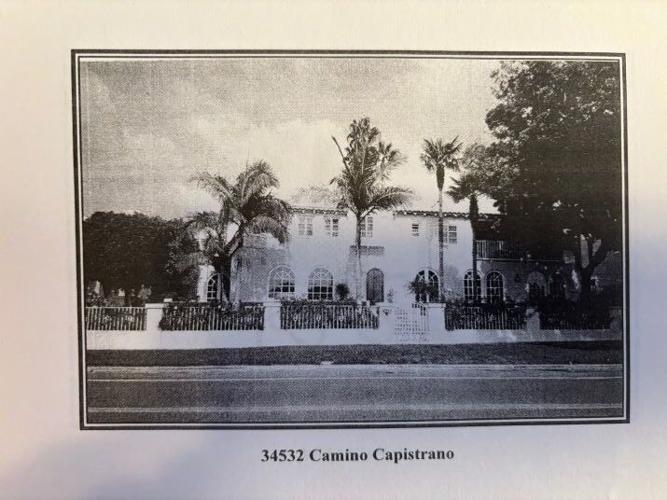Homes like Capistrano Beach resident Steven Abraham’s come with their own stories.
Abraham’s home was built by Ned Doheny, son of the developer and oil tycoon Edward Doheny, in 1929, though Ned died the same year under circumstances still speculated upon today.
After living in his historic home on Camino Capistrano the past 13 years, Abraham put the compound on the market as he looks for a buyer who will appreciate its unique story and charm.
“I always want something with a story. This house had a story,” Abraham said. “Those are important things to me, because we can always have new, but I had to have a story.”
“There’s a certain sophistication to a historic property, and you either like it or you don’t,” Abraham continued. “My grandmother used to say there’s a pot for every lid. There’s a right buyer for this house.”
Since it was built in 1929, the home has served many different uses, from a chinchilla farm to a bed and breakfast residence, to a private home, Abraham said.
“I really didn’t know about the chinchilla farm at the time (of buying the home) and I did know a little bit about the bed and breakfast, which was fascinating,” Abraham said. “Delving in a little more with the Doheny family, it just became a fascination.”
When Abraham bought the property in 2012, he had researched the history of the home and learned that Ned Doheny, son of Edward Doheny, began developing homes in Capistrano Beach in the Spanish Colonial Revival architectural style after seeing it at the World’s Fair in Panama.
“I love architecture, and this property has special features that are very common with Spanish Colonial architecture,” Abraham said. “For instance, this window appears to be just an attractive window. In truth, it was a form of air conditioning. You would open the window and the air would hit the three stars and diffuse.”
Previous owners gave Abraham a booklet detailing the “Untold Story” of the historic home, which they had prepared ahead of the Dana Point Historical Society’s tour of the home in 2000.
Abraham continued to dive into the home’s history as he began purchasing fixtures and making modifications to the home’s interior, looking to keep the style within the period of the home’s development.
“I started doing a lot of research,” Abraham said. “I spoke to various architects, I studied the period. … The more you learn, the more you want to learn, and it was just a fascination to me, but I wanted to make sure whatever I did fit within that period.”
Abraham sought to include vintage fixtures, featuring a peacock motif throughout the home, which he noted was popular in 1920s decor.

A photo of the historic home built in 1929.
Photo: Courtesy of Steven Abraham
Walking into the entry foyer, the floor tiles are all original, Abraham said. Just to the left of the entry, the living room features an original fireplace, though Abraham added painted tiles and a wood mantle.
Among the changes he made to the home, Abraham transformed the original kitchen into a library, wrapping the walls in vintage Douglas fir wood and adding a tray ceiling with Venetian plaster. Abraham also turned the pool house into a speakeasy and added a wine cellar.
Previous owners had added in a drop ceiling, which hid the original hand-hewn, stenciled beam ceilings. Abraham noted that the drop ceiling ended up preserving the original beams, which were uncovered when later owners removed the drop ceiling.
As a real estate broker who has sold historic properties throughout the U.S., Abraham said he has a fascination with historic properties. The Doheny property is registered as a Mills Act historic home. The Mills Act grants qualifying historic property owners who work to restore and maintain the property a break on their property taxes.
“The Mills Act will allow a discounted property tax, which is huge,” Abraham said. “That allows you to invest more money into the property.”
“There’s no negatives,” Abraham continued. “You can do whatever you wish within a conversation with the Historic Society, with the city, of course, with permits. But you can basically make it as livable as you want, and they just ask that you keep the facade the same, if possible.”
Abraham emphasized that his home on Camino Capistrano is “the most enjoyable property I’ve ever owned for location, proximity to the beach, all of the wonderful benefits to the property and the historical significance of the property.”
“The person that purchases this home will love it and enjoy it, and their family will love it,” Abraham said. “I call it an heirloom property for a reason, because it truly is a property you want to keep in your family.”
Abraham noted that living in the historic home has been “peaceful, enjoyable.”
“I hate to leave it, but it’s that time,” Abraham said, adding that he’s getting remarried and moving in with his partner. “It’s been nothing but a great experience.”
“I love people, and the beauty of this property is that everybody wants to know about the history of the property,” Abraham continued. “It’s the anchor of the neighborhood, and every single day I’m outside, someone walks by to say, ‘This is my favorite house.’ ”
The ideal buyer for this home should first and foremost have “a real appreciation for the historic significance of the property and to want to try to keep it and remain or at least build on what I’ve started,” Abraham said.
The 4,900-square-foot home at 34532 Camino Capistrano in Capistrano Beach is listed for $6 million.

13 Responses